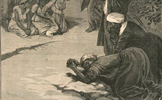The disaster had a profound effect on mental health, triggering countless episodes of what we would now term post-traumatic stress disorder. People complained of nausea and headaches. When one woman lost most of her hair, which fell out in clumps, her doctor diagnosed “paralysis of the scalp” caused by fright. Within days of the quake the Charleston News and Courier reported that three women had been “frightened to death.”
To calm their fears, countless residents swallowed sedatives: morphine, laudanum, red lavender, valerian, and alcohol-based patent medicines. “I cannot live without my powders,” a schoolteacher confessed. “I sleep very little at night and am very nerveless in the morning.” Others fled to the bars, which were open for business within hours of the quake.
The earthquake triggered many strange afflictions, even in cities far from the epicenters. According to the Savannah Morning News, at least a dozen people went insane and had to be sent to lunatic asylums, including “the wives and daughters of prominent citizens.” A drugstore clerk started walking on Tuesday night and didn’t stop until he reached a town fifty miles away, where he sent a postcard to his parents saying he could not return.
Even animals were affected. Sailors who were out in the harbor during the quake swore that “numbers of fish jumped out of the water, apparently frightened to death.” Countless fireflies congregated in a swamp close to Kingstree. Roosting birds tumbled from the trees on Pawley’s Island. In Charleston, armies of rats and roaches were observed evacuating damaged houses.
As if the first shock wasn’t bad enough, for months the area was shaken by aftershocks. Two weeks after the quake, the News and Courier noted that aftershocks still were coming about once every 16 hours. Three hundred aftershocks were reported in the next thirty months. The anxiety that this continual shaking caused was considerable. One physician wrote to a colleague, “I can scarcely write as my mind is not clear enough from the Mental perturbation which I has pass through.”
The city did not have a psychiatric facility in 1886. Patients who showed signs of serious mental illness might be kept for a short time in the City Hospital, but those who did not improve quickly were usually moved to the state facility, called the “lunatic asylum,” in Columbia.



